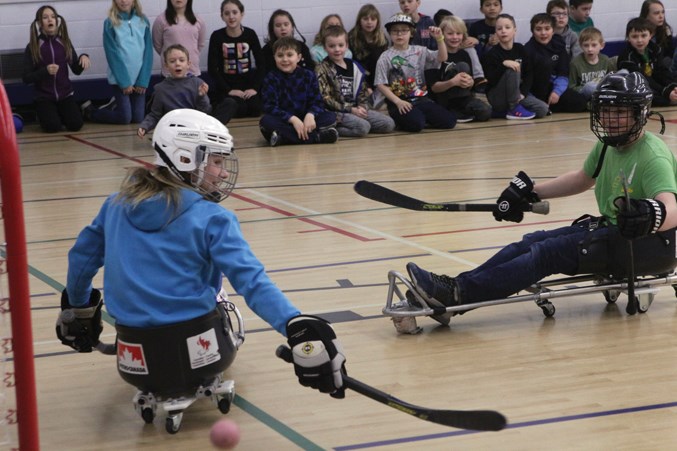Students got some hands-on experience playing a real Paralympic sport last week and learned a little something about accessibility at the same time.
The Westlock Accessibility Committee organized the Feb. 12 sledge hockey event, which saw students at Westlock Elementary School play an indoor version of the game in the morning and then there was a full presentation involving local junior high schools on the ice at the Rotary Spirit Centre in the afternoon.
Sledge hockey is a modified version of hockey for people who are not able to skate. Players sit in sleds with skates, or wheels, and propel themselves using the back-ends of a pair of shortened hockey sticks.
Rules are essentially the same, except for the addition of a penalty for T-boning another player.
“It’s fun, but it’s really hard,” said St. Mary student Dylan Biddiscombe. “My arms are getting pretty sore just from pushing.”
Former Team Canada player Zach Savage made a brief appearance to wish the students well and representatives from the Paralympic Sports Association were also on hand to assist students in playing the sport. Players competed in two half-ice games as over 50 students tested their balance and agility on the sleds.
A few adults got into the action as well. Westlock Warriors captain Mike Ivey strapped into the sled for a game and Warriors No. 1 fan Matt Steinbring got his first taste of the game in 13 years.
“I used to do it for fun,” he said, adding it was a lot of fun to get back in the seat. “It was quite a workout.”
MCed by Miss Wheelchair Canada 2018 Bean Gill, the afternoon showcase was a fun way to raise awareness of the challenges faced by people with disabilities that others may take for granted and to promote better accessibility in infrastructure.
“It’s about changing the stigma around people with disabilities. We just want to be seen as regular people ... because we are regular people,” she said.
“I was naive to a lot of things before I was paralyzed. Parking for one, curb cuts being another. Canada in general loves having curves everywhere, so that is a big nuisance.
“There’s a lot of small things that when you’re standing don’t make a difference to you, but when you’re sitting it’s a different perspective.”
Gill said she had to completely rework her life after a virus rendered her paralyzed from the waist down in 2012. However, having fought through adversity she has accomplished a lot, working as an x-ray technologist and a high-end makeup artist.
Organizer Susan Littlechilds of the Westlock Accessibility Committee thanked the schools for their participation and reminded the packed arena that improving accessibility was beneficial to everyone.
“People with disabilities face barriers every day in terms of accessibility. This includes people with mobility challenges, visual challenges and cognitive challenges,” she said.
“This isn’t just people with chronic disabilities, but also people with temporary mobility issues, such as need for crutches or even the pushing of a stroller.
“A disability is only a problem when you set it up against a barrier. If you remove these barriers, then you remove the limitation.”



